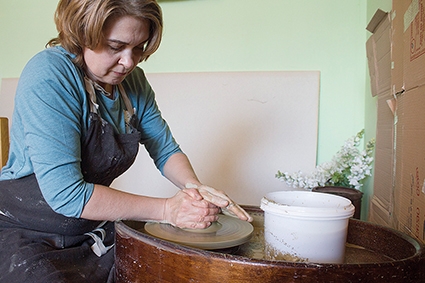From the Miry Clay: Etseri, Svaneti
Blog
This is a first. Among our current group of guests for two weeks, seven foreigners based in Tbilisi, are a couple from Nizhniy Novgorod (formerly Gorky), Russia, who have uprooted themselves in the process of meeting some of their Georgian cousins, and resettled in Mtskheta. She is a potter, with dreams of helping to revive this ancient industry and art in the country’s old capital.
And they have brought with them an electric potter’s wheel, proper clay and all the necessary tools! Local children are getting their hands into it with great gusto, hand-building all manner of exotic things and creatures every day after school, and a few of the older ones are also trying their hand at the wheel.
This takes me, too, back to my first ever time at this art. I joined the local Potters’ Guild of my town in Canada, Stony Plain, Alberta, in 1986. A requirement was that every new member take at least one wheel course, and also buy their clay and glazes through the guild, which offered facilities and firing in their big gas-fired kilns. I became an avid potter, as well as a sculptor and founding member of the Sculptors’ Association of Alberta.
I must have had a stroke of beginner’s luck, because after years of watching potters on TV or live, the very first time I sat at a wheel myself, a small stoneware vessel emerged which was good enough to keep. I have it to this day, here at home in Etseri. If anyone else has experienced the sheer magic of not only watching, but successfully centering and making something from a lump of the featureless mass, you know what I’m talking about.
Then the work must be dried slowly enough to prevent cracks, until it reaches the state we call “bone dry”. At this point, however, it can still be broken with ease (being its most fragile), and even dissolved back into a pliable state and reused.
Then comes the bisque or first, low-temperature firing in the kiln, which drives out all the remaining chemical water from the composition of the clay and makes it forever impervious to dissolution in water. Glazes can then be applied, if you like; their colors may be nothing like what the next firing will show. This is usually the final firing, which takes the clay near (but not too near) to its point of vitrification, past which it would melt like glass. For earthenware, the second firing it still a comparatively low temperature; but both stoneware and the usually translucent porcelain need a much higher second firing, up to 1400 degrees C or 2552 F, to finish them. Now they can—and sometimes do—last many thousands of years, having achieved a composition similar to rock: brittle, but very hard indeed.
I still need to see how the producers of the huge clay kvevrebi, the Georgian wine amphorae sometimes big enough to enter, actually make and then fire them. The center of this process seems to be Shrosha, near the Roki Pass separating eastern from western Georgia, with permanent displays of wares for sale from small cups all the way up to the full-size wine vessels with necks a foot or two across.
As for Georgian art pottery and sculpture, this too has been around for a very long time and awaits discovery by the enthusiast or collector. Ah, so many possibilities, so little time. But I am thrilled that new friends of mine are both introducing local Georgians to these crafts and seeking to reestablish them in their original locations. Projects dear to my heart.
P.S For videos of the children in action, please see the Hanmer Guest House FB page, details below.
Tony Hanmer has lived in Georgia since 1999, in Svaneti since 2007, and been a weekly writer for GT since early 2011. He runs the “Svaneti Renaissance” Facebook group, now with nearly 2000 members, at www.facebook.com/groups/SvanetiRenaissance/
He and his wife also run their own guest house in Etseri:
www.facebook.com/hanmer.house.svaneti
By Tony Hanmer












